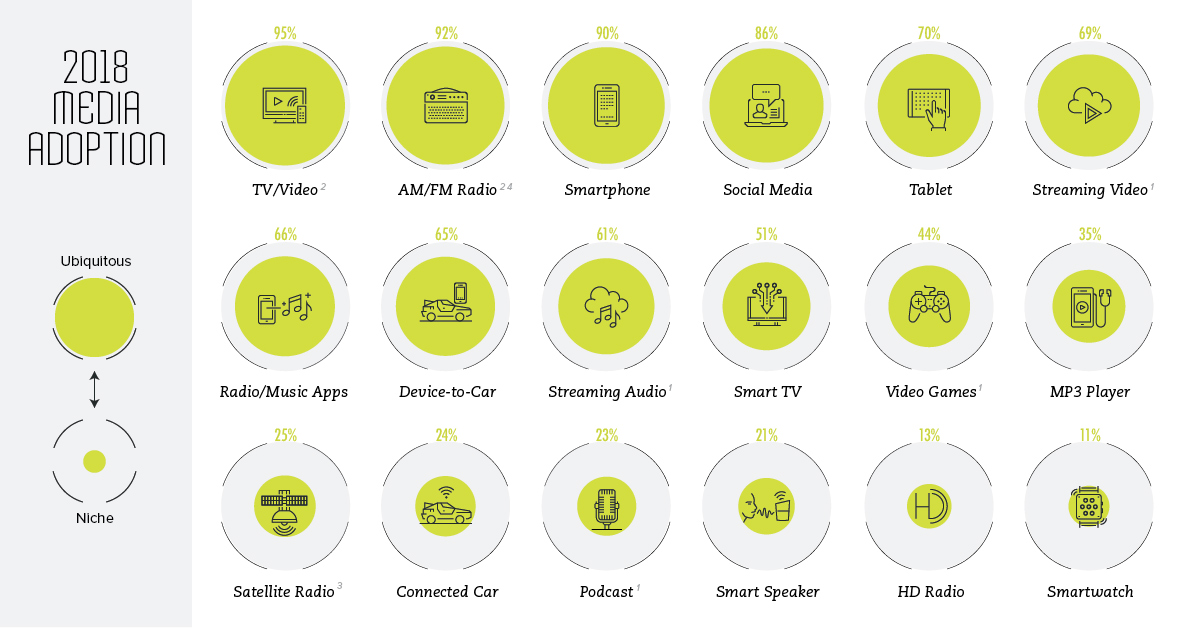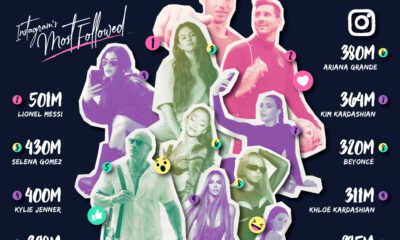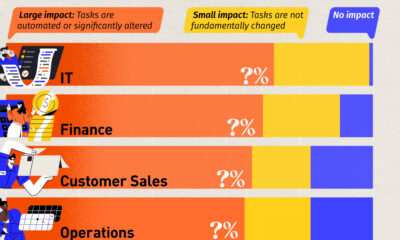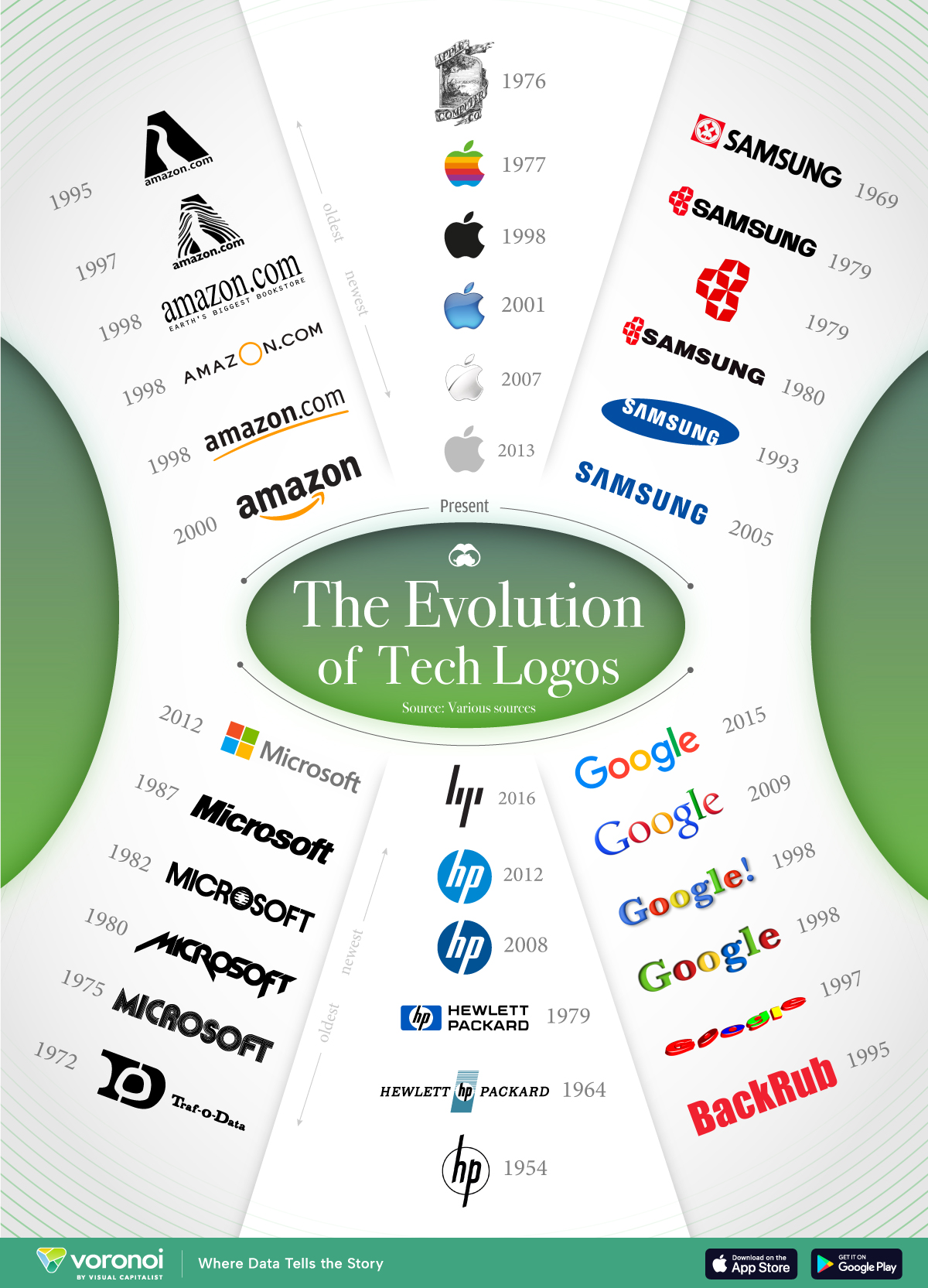Technology
18 Media Technologies, Sorted by Adoption Rate

18 Media Technologies, Sorted by Adoption Rate
The Chart of the Week is a weekly Visual Capitalist feature on Fridays.
As you read this, know that you are not alone.
Statistically speaking, over 50% of people are consuming media in some form at this given moment.
In fact, the latest data shows that Americans spend over 12 hours per day consuming media in various forms. This means that people spend more time consuming media than they do working or sleeping – a prolific insight that explains why companies like Apple, Alphabet, Facebook, and Netflix have exploded in size and dominance over the last decade.
Media Adoption in 2018
Using the most recent survey data from Jacobs Media, we can get a sense of how all of this media is actually being consumed.
The following data shows the survey results of 64,289 radio listeners in North America to highlight the adoption rates for 18 different media technologies, ranging from television to smartwatches.
| Rank | Media Type | Adoption Rate |
|---|---|---|
| #1 | TV/Video | 95% |
| #2 | AM/FM Radio | 92% |
| #3 | Smartphone | 90% |
| #4 | Social Media | 86% |
| #5 | Tablet | 70% |
| #6 | Streaming Video | 69% |
| #7 | Radio/Music Apps | 66% |
| #8 | Device-to-Car | 65% |
| #9 | Streaming Audio | 61% |
| #10 | Smart TV | 51% |
| #11 | Video Games | 44% |
| #12 | MP3 Plaer | 35% |
| #13 | Satellite Radio | 25% |
| #14 | Connected Car | 24% |
| #15 | Podcast | 23% |
| #16 | Smart Speaker | 21% |
| #17 | HD Radio | 13% |
| #18 | Smartwatch | 11% |
Conventional mediums like television still reign supreme for now.
However, it’s worth noting that the intersection of media and technology is a rapidly-evolving space – and there are several mediums that are jumping up the rankings fast.
Movers and Shakers
We previously covered the ultra-competitive battle for smart speaker market share, and the data here gives further indication to how fast the space is evolving. In the 2018 edition of the survey, smart speakers held a 21% penetration rate – that’s almost double the rate in the 2017 survey, which was only at 11%.
In the video streaming space, Netflix continues its rapid growth – something that was also evident in the internet minute graphic that we shared with you earlier in the week. Users watching Netflix at least once per week jumped from 41% to 52% between 2017 and 2018.
Finally, in other brand news, Facebook is used on a weekly basis by 74% of respondents. Other social media platforms like Instagram and Snapchat were well behind Facebook in overall media usage, but are still growing in terms of users.
Brands
How Tech Logos Have Evolved Over Time
From complete overhauls to more subtle tweaks, these tech logos have had quite a journey. Featuring: Google, Apple, and more.
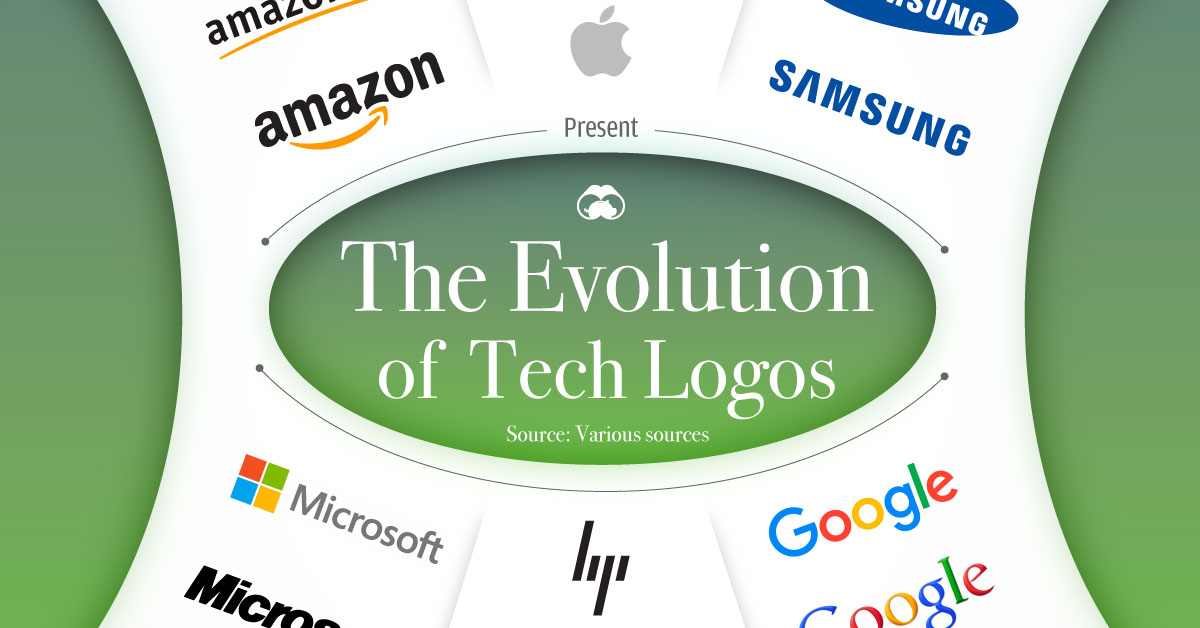
How Tech Logos Have Evolved Over Time
This was originally posted on our Voronoi app. Download the app for free on iOS or Android and discover incredible data-driven charts from a variety of trusted sources.
One would be hard-pressed to find a company that has never changed its logo. Granted, some brands—like Rolex, IBM, and Coca-Cola—tend to just have more minimalistic updates. But other companies undergo an entire identity change, thus necessitating a full overhaul.
In this graphic, we visualized the evolution of prominent tech companies’ logos over time. All of these brands ranked highly in a Q1 2024 YouGov study of America’s most famous tech brands. The logo changes are sourced from 1000logos.net.
How Many Times Has Google Changed Its Logo?
Google and Facebook share a 98% fame rating according to YouGov. But while Facebook’s rise was captured in The Social Network (2010), Google’s history tends to be a little less lionized in popular culture.
For example, Google was initially called “Backrub” because it analyzed “back links” to understand how important a website was. Since its founding, Google has undergone eight logo changes, finally settling on its current one in 2015.
| Company | Number of Logo Changes |
|---|---|
| 8 | |
| HP | 8 |
| Amazon | 6 |
| Microsoft | 6 |
| Samsung | 6 |
| Apple | 5* |
Note: *Includes color changes. Source: 1000Logos.net
Another fun origin story is Microsoft, which started off as Traf-O-Data, a traffic counter reading company that generated reports for traffic engineers. By 1975, the company was renamed. But it wasn’t until 2012 that Microsoft put the iconic Windows logo—still the most popular desktop operating system—alongside its name.
And then there’s Samsung, which started as a grocery trading store in 1938. Its pivot to electronics started in the 1970s with black and white television sets. For 55 years, the company kept some form of stars from its first logo, until 1993, when the iconic encircled blue Samsung logo debuted.
Finally, Apple’s first logo in 1976 featured Isaac Newton reading under a tree—moments before an apple fell on his head. Two years later, the iconic bitten apple logo would be designed at Steve Jobs’ behest, and it would take another two decades for it to go monochrome.
-
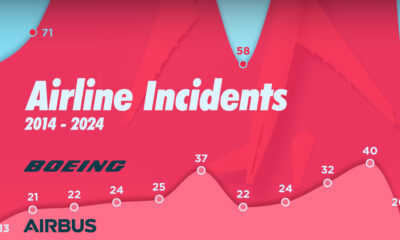
 Travel1 week ago
Travel1 week agoAirline Incidents: How Do Boeing and Airbus Compare?
-

 Markets2 weeks ago
Markets2 weeks agoVisualizing America’s Shortage of Affordable Homes
-

 Green2 weeks ago
Green2 weeks agoRanked: Top Countries by Total Forest Loss Since 2001
-

 Money2 weeks ago
Money2 weeks agoWhere Does One U.S. Tax Dollar Go?
-

 Misc2 weeks ago
Misc2 weeks agoAlmost Every EV Stock is Down After Q1 2024
-

 AI2 weeks ago
AI2 weeks agoThe Stock Performance of U.S. Chipmakers So Far in 2024
-

 Markets2 weeks ago
Markets2 weeks agoCharted: Big Four Market Share by S&P 500 Audits
-

 Real Estate2 weeks ago
Real Estate2 weeks agoRanked: The Most Valuable Housing Markets in America

